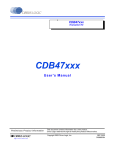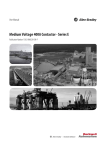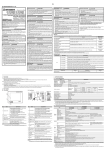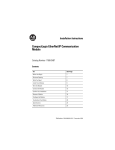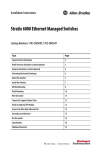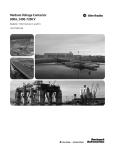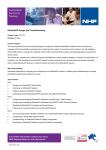Download EtherNet/IP Daughtercard
Transcript
Installation Instructions EtherNet/IP Daughtercard Catalog Number 1788-ENBT Use this document as a guide to install the EtherNet/IP daughtercard. This document covers only the hardware installation; refer to the FlexLogix System User Manual, publication 1794-UM001, for information about configuring the daughtercard. This table lists the contents of the document and where to find specific information. For information about See page Important User Information 2 About the EtherNet/IP Daughtercard 4 Required Software 4 Related Publications 4 Identifying Daughtercard Components 4 Install the Daughtercard 5 Connect the Daughtercard to the Network 5 Apply Host Power 6 Daughtercard System Performance 6 Interpret the LED Status Indicators 7 Where to Find Information on Configuring the Daughtercard 9 Hazardous Location Information 10 Specifications 11 Publication 1788-IN054A-EN-P - September 2002 2 EtherNet/IP Daughtercard Important User Information Because of the variety of uses for the products described in this publication, those responsible for the application and use of these products must satisfy themselves that all necessary steps have been taken to assure that each application and use meets all performance and safety requirements, including any applicable laws, regulations, codes and standards. In no event will Rockwell Automation, Inc. be responsible or liable for indirect or consequential damage resulting from the use or application of these products. Any illustrations, charts, sample programs, and layout examples shown in this publication are intended solely for purposes of example. Since there are many variables and requirements associated with any particular installation, Rockwell Automation does not assume responsibility or liability (to include intellectual property liability) for actual use based upon the examples shown in this publication. Allen-Bradley publication SGI-1.1, Safety Guidelines for the Application, Installation and Maintenance of Solid-State Control (available from your local Rockwell Automation office), describes some important differences between solid-state equipment and electromechanical devices that should be taken into consideration when applying products such as those described in this publication. Reproduction of the contents of this copyrighted publication, in whole or part, without written permission of Rockwell Automation, is prohibited. Throughout this publication, notes may be used to make you aware of safety considerations. The following annotations and their accompanying statements help you to identify a potential hazard, avoid a potential hazard, and recognize the consequences of a potential hazard: WARNING Identifies information about practices or circumstances that can cause an explosion in a hazardous environment, which may lead to personal injury or death, property damage, or economic loss. ! ATTENTION Identifies information about practices or circumstances that can lead to personal injury or death, property damage, or economic loss. ! IMPORTANT Identifies information that is critical for successful application and understanding of the product. Publication 1788-IN054A-EN-P - September 2002 EtherNet/IP Daughtercard ATTENTION ! 3 Environment and Enclosure This equipment is intended for use in a Pollution Degree 2 industrial environment, in overvoltage Category II applications (as defined in IEC publication 60664-1), at altitudes up to 2000 meters without derating. This equipment is considered Group 1, Class A industrial equipment according to IEC/CISPR Publication 11. Without appropriate precautions, there may be potential difficulties ensuring electromagnetic compatibility in other environments due to conducted as well as radiated disturbance. This equipment is supplied as “open type” equipment. It must be mounted within an enclosure that is suitably designed for those specific environmental conditions that will be present and appropriately designed to prevent personal injury resulting from accessibility to live parts. The interior of the enclosure must be accessible only by the use of a tool. Subsequent sections of this publication may contain additional information regarding specific enclosure type ratings that are required to comply with certain product safety certifications. See NEMA Standards publication 250 and IEC publication 60529, as applicable, for explanations of the degrees of protection provided by different types of enclosure. Also, see the appropriate sections in this publication, as well as the Allen-Bradley publication 1770-4.1 (“Industrial Automation Wiring and Grounding Guidelines”), for additional installation requirements pertaining to this equipment. ATTENTION ! Preventing Electrostatic Discharge This equipment is sensitive to electrostatic discharge, which can cause internal damage and affect normal operation. Follow these guidelines when you handle this equipment: • • • • • • Touch a grounded object to discharge potential static. Wear an approved grounding wriststrap. Do not touch connectors or pins on component boards. Do not touch circuit components inside the equipment. If available, use a static-safe workstation. When not in use, store the equipment in appropriate static-safe packaging. Publication 1788-IN054A-EN-P - September 2002 4 EtherNet/IP Daughtercard About the EtherNet/IP Daughtercard 31447-M The network daughtercard architecture defines a common hardware and software interface that several different network interface cards will support. This lets products that have been designed to support the network daughtercard option support several different Rockwell Automation networks. You can install the 1788-ENBT EtherNet/IP daughtercard in any host device that supports the daughtercard.(1) Required Software Use RSLogix 5000 programming software V11 or later to configure a FlexLogix/DriveLogix system for use with the EtherNet/IP daughtercard. Related Publications Publication Title Publication Number EtherNet/IP System Overview ENET-SO001 EtherNet/IP Media Planning and Installation Manual ENET-IN001 EtherNet/IP Performance and Application Guide ENET-AP001 FlexLogix System User Manual 1794-UM001 EtherNet/IP Daughtercard User Manual 1788-UM054 Identifying Daughtercard Components module status LED M S network status LED N S E N E T LNK U% RJ45 cable connector (1) link status LED utilization percent LED The host device must provide suitable power source per the restrictions in the specifications table on page 11. Publication 1788-IN054A-EN-P - September 2002 EtherNet/IP Daughtercard 5 Install the Daughtercard Due to wide variation in available host devices, we cannot provide specific installation instructions in this document. For instructions on how to install the daughtercard in a host device, refer to the user manual for the particular host device. IMPORTANT WARNING Do not insert or remove the daughtercard while the host is under power. The daughtercard is not designed to be inserted or removed while the host is powered. Inserting or removing the module while host power is on may cause an electrical arc. This could cause an explosion in hazardous location installations. ! Connect the Daughtercard to the Network After you have installed the daughtercard, you can connect it to the network via the RJ45 connector. WARNING ! If you insert or remove the card while host power is on OR if you connect or disconnect the Ethernet cable with power applied to this module or any device on the network, an electrical arc can occur. Either could cause an explosion in hazardous location installations. Be sure that power is removed or the area is nonhazardous before proceeding. Publication 1788-IN054A-EN-P - September 2002 6 EtherNet/IP Daughtercard 1. Use an RJ45 connector to connect to the EtherNet/IP network. Wire the connector according to this illustration: 8 ------ NC 7 ------ NC 6 ------ RD5 ------ NC 4 ------ NC 3 ------ RD+ 2 ------ TD1 ------ TD+ 2. Attach the connector to the EtherNet/IP port on the daughtercard. IMPORTANT We recommend connecting the module to the network via a 100MB Ethernet switch, which will reduce collisions and lost packets and increase network bandwidth. For detailed EtherNet/IP connection information, see the following publications: – – EtherNet/IP Performance and Application Guide, publication ENET-AP001 EtherNet/IP Media Planning and Installation Guide, publication ENET-IN001 Apply Host Power To power the EtherNet/IP daughtercard, apply power to the host. Daughtercard System Performance Due to wide variation in available host devices, we cannot provide specific performance capabilities in this document. For information concerning host/daughtercard performance characteristics, refer to the user manual for the particular host device. Publication 1788-IN054A-EN-P - September 2002 EtherNet/IP Daughtercard 7 Interpret the LED Status Indicators The four status indicators on the daughtercard provide information about the network, the daughtercard, and its connections. The following tables outline the possible states, explain what each state means, and indicate what action you should take, if any, to correct that state. Module Status (MS) Indicator This LED indicates whether or not the daughtercard has power and is operating properly. Condition Status Indicates Recommended Action off no power The daughtercard does not have power. Check the host power supply. Verify that the daughtercard is firmly seated in the host’s slot. Replace daughtercard and/or host. flashing green standby The daughtercard does not have an IP address and is operating in BOOTP mode. Verify that the BOOTP server is running. green OK The daughtercard is operating correctly. Normal operation. No action required. red held in reset The host is holding the daughtercard in reset or the host is faulted. Verify that the daughtercard is firmly seated in the host’s slot. Clear the host’s fault. Replace daughtercard and/or host. self-test The daughtercard is performing its power-up self-test. Normal operation during powerup. major fault An unrecoverable fault has occurred. Cycle power to the host. Replace the daughtercard and/or host. flashing red updating firmware The daughtercard firmware is being updated. Normal operation during firmware update. No action required. Publication 1788-IN054A-EN-P - September 2002 8 EtherNet/IP Daughtercard Network Status (NS) Indicator This LED indicates whether or not the daughtercard has an IP address and whether or not connections are established. Condition Status Indicates Recommended Action off not initialized The daughtercard does not have an IP address and is operating in BOOTP mode. Verify that the BOOTP server is running. flashing green no CIP connections established The daughtercard has an IP address, but no CIP connections are established. Normal operation if no connections are configured. No action required. If connections are configured, check connection originator for connection error code. green CIP connections established The daughtercard has an IP address and CIP connections (Class 1 or Class 3) are established. Normal operation. No action required. red duplicate IP address The daughtercard has detected that the assigned IP address is already in use. Verify that all IP addresses are unique. flashing red/green self-test The daughtercard is performing its power-up self-test. Normal operation during powerup. Link Status (LNK) Indicator This LED indicates whether or not the daughtercard is communicating on the Ethernet link. Condition Status Indicates Recommended Action off no link The daughtercard is not connected to a powered Ethernet device. The daughercard cannot communicate on Ethernet. Verify that all Ethernet cables are connected. Verify that Ethernet switch is powered. flashing green self-test The daughtercard is performing its power-up self-test. Normal operation during powerup. data transmission and reception The daughtercard is communicating on Ethernet. Normal operation. No action required. link okay The daughtercard is connected to a powered Ethernet device. The daughtercard can communicate on Ethernet. Normal operation. No action required. green Publication 1788-IN054A-EN-P - September 2002 EtherNet/IP Daughtercard 9 Utilization Percent (U%) Indicator This LED indicates utilization percent of the daughtercard only and does not address the system performance of the daughtercard plus host. Condition Status Indicates Recommended Action off less than 80% utilization The I/O packet rate to/from this daughtercard is less than 80% of the available packet rate and less than 80% of the 32 available I/O connections are currently in use. Normal operation. No action required. flashing green 80% packet rate reached The I/O packet rate to/from this daughtercard is at least 80% of the available packet rate (4000 packets/sec). That is, the I/O packet rate is at least 3200 packets/sec. Normal operation. No action required. 80% connections in use At least 80% of the 32 available connections are currently in use. That is, from 26 to 31 I/O connections are in use. Normal operation. No action required. green all connections in use All 32 of the daughtercard’s I/O connections are currently in use. Normal operation when all 32 I/O connections are in use. flashing red/green self-test The daughtercard is performing its power-up self-test. Normal operation during powerup. Where to Find Information on Configuring the Daughtercard Now that you have installed your EtherNet/IP daughtercard, you must configure it. Refer to your FlexLogix System User Manual, publication 1794-UM001. Publication 1788-IN054A-EN-P - September 2002 10 EtherNet/IP Daughtercard Hazardous Location Information The following information applies when operating this equipment in hazardous locations: Informations sur l’utilisation de cet équipement en environnements dangereux : Products marked “CL I, DIV 2, GP A, B, C, D” are suitable for use in Class I Division 2 Groups A, B, C, D, Hazardous Locations and nonhazardous locations only. Each product is supplied with markings on the rating nameplate indicating the hazardous location temperature code. When combining products within a system, the most adverse temperature code (lowest “T” number) may be used to help determine the overall temperature code of the system. Combinations of equipment in your system are subject to investigation by the local Authority Having Jurisdiction at the time of installation. Les produits marqués "CL I, DIV 2, GP A, B, C, D" ne conviennent qu’à une utilisation en environnements de Classe I Division 2 Groupes A, B, C, D dangereux et non dangereux. Chaque produit est livré avec des marquages sur sa plaque d’identification qui indiquent le code de température pour les environnements dangereux. Lorsque plusieurs produits sont combinés dans un système, le code de température le plus défavorable (code de température le plus faible) peut être utilisé pour déterminer le code de température global du système. Les combinaisons d’équipements dans le système sont sujettes à inspection par les autorités locales qualifiées au moment de l’installation. WARNING ! EXPLOSION HAZARD • Do not disconnect equipment unless power has been removed or the area is known to be nonhazardous. • Do not disconnect connections to this equipment unless power has been removed or the area is known to be nonhazardous. Secure any external connections that mate to this equipment by using screws, sliding latches, threaded connectors, or other means provided with this product. • Substitution of components may impair suitability for Class I, Division 2. • If this product contains batteries, they must only be changed in an area known to be nonhazardous. Publication 1788-IN054A-EN-P - September 2002 AVERTISSEMENT ! RISQUE D’EXPLOSION • Couper le courant ou s’assurer que l’environnement est classé non dangereux avant de débrancher l'équipement. • Couper le courant ou s'assurer que l’environnement est classé non dangereux avant de débrancher les connecteurs. Fixer tous les connecteurs externes reliés à cet équipement à l'aide de vis, loquets coulissants, connecteurs filetés ou autres moyens fournis avec ce produit. • La substitution de composants peut rendre cet équipement inadapté à une utilisation en environnement de Classe I, Division 2. • S’assurer que l’environnement est classé non dangereux avant de changer les piles. EtherNet/IP Daughtercard 11 Specifications Characteristic Value Power Requirements 5V dc @ 465mA(1) Power Consumption 5 V dc, 2.33W Thermal Dissipation 8.0 BTU/hr Isolation Voltage Tested to withstand 500V ac for 60 seconds Ethernet Conductors Wiring 802.3 compliant - twisted pair Category 2(2) Ethernet Connector RJ45 Category 5 Emissions CISPR 11: Group 1, Class A (with appropriate enclosure) ESD Immunity IEC 61000-4-2: 6kV contact discharges 8kV air discharges Radiated RF Immunity IEC 61000-4-3: 10V/m with 1kHz sine-wave 80%AM from 30MHz to 2000MHz 10V/m with 200Hz 50% Pulse 100%AM at 900Mhz EFT/B Immunity IEC 61000-4-4: ±2kV at 5kHz on communications ports Surge Transient Immunity IEC 61000-4-5: ±2kV line-earth (CM) on communications ports Conducted RF Immunity IEC 61000-4-6: 10Vrms with 1kHz sine-wave 80%AM from 150kHz to 80MHz Enclosure Type Rating None (open-style) Operating Temperature IEC 60068-2-1 (Test Ad, Operating Cold), IEC 60068-2-2 (Test Bd, Operating Dry Heat), IEC 60068-2-14 (Test Nb, Operating Thermal Shock): This product is suitable for application in equipment that is rated 0 to 60oC (32 to 140oF) maximum. It is acceptable for the ambient slot temperature immediately surrounding this product to reach 85oC (185oF) maximum. Storage Temperature IEC 60068-2-1 (Test Ab, Un-packaged Non-operating Cold), IEC 60068-2-2 (Test Bb, Un-packaged Non-operating Dry Heat), IEC 60068-2-14 (Test Na, Un-packaged Non-operating Thermal Shock): –40 to 85°C (–40 to 185°F) Relative Humidity IEC 60068-2-30 (Test Db, Un-packaged Non-operating Damp Heat): 5 to 95% non-condensing Shock IEC60068-2-27 (Test Ea, Unpackaged Shock): Operating 30g Non-operating 50g Publication 1788-IN054A-EN-P - September 2002 Vibration IEC60068-2-6 (Test Fc, Operating): 5g @ 10-500Hz Weight 0.1 kg (0.2 lb.) Certifications: (when product is marked) c-UR-us (1) (2) (3) UL Recognized Component Industrial Control Equipment for Class I, Division 2 Group A,B,C,D Hazardous Locations, certified for US and Canada. European Union 89/336/EEC EMC Directive, compliant with: CE(3) EN 61000-6-4; Industrial Emissions EN 50082-2; Industrial Immunity EN 61326; Meas./Control/Lab., Industrial Requirements EN 61000-6-2; Industrial Immunity Australian Radiocommunications Act, compliant with: C-Tick(3) AS/NZS 2064; Industrial Emissions EtherNet/IP ODVA conformance tested to EtherNet/IP specifications. To comply with UL restrictions, this equipment must be powered from a source compliant with the following: Class 2 or Limited Voltage/Current, as defined in UL 508 Seventeenth Edition Section 32. For information on conductor routing refer to publications 1770-4.1, Industrial Automation Wiring and Grounding Guidelines, and ENET-IN001, EtherNet/IP Media Planning and Installation Manual. See the Product Certification link at www.ab.com for Declarations of Conformity, Certificates, and other certification details. Allen-Bradley, FlexLogix, and DriveLogix are trademarks of Rockwell Automation, Inc. RSLogix is a trademark of Rockwell Software, Inc. Publication 1788-IN054A-EN-P - September 2002 PN 957678-55 © 2002 Rockwell Automation. Printed in the U.S.A.












